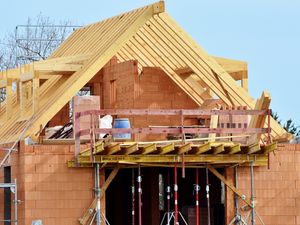How to add value to your property
More people are making the most of the current low interest rates to borrow money to improve their home - check out Cathy Stanworth's complete guide to adding value to your property.

 More people are making the most of the current low interest rates to borrow money to improve their home, and view the spending as an investment for the future.
More people are making the most of the current low interest rates to borrow money to improve their home, and view the spending as an investment for the future.
The top five home improvements are currently:
adding central heating
having a new kitchen
fitting a new bathroom
adding insulation
an extension
But pouring cash into home improvements offers no cast-iron guarantee that you will increase your home's value.
As a general rule, if you're going to make alterations, then you should do it because you want to for your own convenience and comfort, rather than to simply add value.
A spokesman for what?price.co.uk said: "At the end of the day, many improvements should add to the saleability of your home, and make a huge difference to selling.
"However that still doesn't stop people from asking what home improvements really pay off when the time comes to sell your house?"
"That answer starts with the fact that really major improvements - room additions, total replacements of kitchens and bathrooms, etc., rarely pay off fully in the near term. It ends with the fact that small and relatively inexpensive changes can pay off in a big way in making your home attractive to buyers if your decision is to move now.
"It's a simple fact, consistently confirmed across the UK over a very long period of time, that even the most appropriate major improvements are unlikely to return their full cost if a house is sold within two or three years."
Does that mean that major home improvements / renovations are always a bad idea? Of course not. It does mean, though, that if your present house falls seriously short of meeting your family's needs you need to think twice - and think carefully - before deciding to undertake a major renovation.
 Viewed strictly in investment terms, big improvements rarely make as much sense as selling your present home and buying one that's carefully selected to give you with what you want.
Viewed strictly in investment terms, big improvements rarely make as much sense as selling your present home and buying one that's carefully selected to give you with what you want.
The what?price.co.uk spokesman said: "Even if you have a special and strong attachment to the home you're in and feel certain that you could be happy in it for a long time if only it had more bedrooms and baths, for example, there are a few basic rules that you ought to keep in mind before undergoing any house renovation.
"Probably the most basic rule of all, in this regard, is the one that says you should never - unless you absolutely don't care at all about eventual resale value - improve a house to the point where its desired sales price would be more than 20 per cent higher than the most expensive of the other houses in the immediate neighbourhood.
"Try to raise the value of your house too high by performing major home improvements and surrounding properties will pull its value down.
Indeed, some "improvements or renovations" can actually reduce your home's value, and your chances of selling at a good price."
So, what are the sure-fire winners, which should pay for themselves and boost saleability when you come to move?
These key points should be considered before booking a builder:
Central heating can be expensive to install in your home but future potential purchasers may be put off if you haven't got it, so you should recoup your money with this improvement.
Secondary-glazing on the inside of existing windows may be preferable to double glazing for a period home with original features. Although you are likely to get back only a third of your money on double glazing, savings will be made on household electricity and heating bills.
The what?price.co.uk spokesman said: "Make sure any improvements are appropriate to the character of the property. Try to avoid replacing old features - such as stained glass, picture rails and original skirting boards with modern ones."
Rooms which add value
An extra bathroom should keep its value, as long as it is not built at the expense of a bedroom. If the property is fairly large and has upward of five bedrooms with one bathroom - converting a bedroom into a bathroom may have appeal and homeowners may possibly break even on their investment.
The what?price.co.uk spokesman said: "A new kitchen is a popular home improvement but homeowners are unlikely to get back more than their original investment."
Knocking through walls may provide additional space but will also provide fewer rooms - and any reduction in rooms could devalue the property.
The what?price.co.uk spokesman said: "Never rearrange the interior of your house in a way that reduces the total number of bedrooms to less than three. Never add a third bathroom to a two-bath house unless you don't care about ever recouping your investment. Garages are sought after features and will almost certainly recoup an investment."
Click through the pages below for our complete guide!
Photograph shown by Philip Bier CENTRAL HEATING
CENTRAL HEATING
As more of us than ever before are actively trying to make our homes more energy efficient, this could be why installing a new central heating system has jumped to the top slot in Britain's favourite home improvements that can also add value.
And the good news is that you can get grants towards the cost.
Saving energy starts with your central heating boiler and equipment, which needs to be working to maximum efficiency in order to avoid fuel wastage and unnecessary high fuel bills. If you need a modern new system or an upgrade, it's best to consult the experts.
The Grant Aided Heating Installers Network (GAIN) is a group of installers who have gained high technical and professional standards.
They need to be technically competent in order to undertake government and other grant work. A Gain spokesman said: "Under Gain criteria, they are also committed to attaining a quality award. Whether your are eligible for a grant or not, heating installations are highly skilled work and should be the responsibility of experts."
The Warm Front Grant has a package of energy efficiency and heating measures up to the value of £2,700 (except where oil central heating is installed or repaired, where a maximum grant of £4,000 is available) for homeowners or those who privately rent their home, providing they meet the Warm Front eligibility criteria.
The Gain spokesman said: "If the property has previously received any measures under Warm Front, the value of the grant available to the existing household under Warm Front will be the balance of £2,700 or £4,000 if oil central heating is involved, less the value of all works previously completed in the property under Warm Front since June 2,000."
From August 2006 a £300 rebate off the cost of installing a new central heating system for all households aged 60 or over, who own or privately rent their home and who are not in receipt of a qualifying Warm Front benefit, became available. The £300 rebate, which forms part of the Warm Front Scheme, can only be used by householders who either have no heating system or one which is inoperable.
Energy suppliers provide grants under the Government's Energy Efficient Commitment (EEC) scheme. Suppliers must encourage and assist their customers to make energy savings, through installing measures such as cavity wall and loft insulation and energy efficient boilers, appliances and light bulbs.
As well as cutting greenhouse gas emission, the EEC is also designed to cut fuel poverty: at least 50 per cent of the energy savings must be focused on low-income households. Offers can be taken up from any of the energy companies, regardless of who supplies the gas and electricity.
The Gain spokesman said: "Depending on the individual local authority, grants and offers for homeowners or private tenants to install heating improvements according to their incomes are available. Some Gain members also install solar panels and wind turbines, which are subject to grants from the Government DTI Low Carbon Building Programme to help provide hot water and electricity."
Gain has contractor members throughout England and Wales. Visit www.gainassociation.org.uk or 01428 654011.nextpage REFITTING A KITCHEN
REFITTING A KITCHEN
It's really quite surprising to find that having a new kitchen installed lies at number two in the top five home improvements as most people expect it to be number one.
But it was knocked off the top of the list a few years ago. People's buying trends always change, and the latest issue to affect our thought-buying process when choosing a new kitchen, is how eco-friendly the firm is and how efficient the appliances are.
We shouldn't be too surprised though. Let's face it, the environment has become a major issue in today's society. More and more people are turning to eco-friendly products and materials and more are recycling than ever before.
Interestingly, this has even been reflected in consumers' views on choosing a kitchen, bathroom or bedroom retailer, when investing in home improvements.
The Kitchen, Bathroom, Bedroom, Specialists Association (KBSA) recently carried out a survey, which provided the following results:
Twenty-five per cent said that their buying decision would be influenced by the retailer's environmental policies.
Forty-one per cent felt that the energy ratings of kitchen appliances is a very important factor when purchasing such items.
Thirty-seven per cent felt that it was 'very important' when purchasing a new kitchen, that wood used by manufacturers is from a sustainable source and a further 35 per cent thought it was 'important'.
These statistics reflect the increase in the significance of environmental issues to consumers, although awareness of different types of environmental products was mixed. For example, only fourteen per cent of those who responded were aware that kitchen doors manufactured from recycled yoghurt pots were available.
"The figures show that consumers are very aware of environmental issues, to the point where they may even be swayed in their decision on what products to buy and who to buy a kitchen from," says KBSA sales and marketing director, Ruth Ward.
DO'S AND DON'TS FOR THE PERFECT REFIT
 Knowing which kitchen you want is one thing, but being able to buy the kitchen you need is another story. There are a lot of things you have to think about when buying a new kitchen. Kitchenbuyersguide.com has great advice to help make your decision a bit easier.
Knowing which kitchen you want is one thing, but being able to buy the kitchen you need is another story. There are a lot of things you have to think about when buying a new kitchen. Kitchenbuyersguide.com has great advice to help make your decision a bit easier.
A spokesman for kitchenbuyersguide.com said: "First it will be important to determine how your kitchen is going to be fitted. Will it be a flat pack, a rigid construction, a custom-built or a non-fitted kitchen? Look for companies that are specialists in the construction you choose. If you choose flat pack units, check if the company delivers a fitting service.
"When you have found your company, check if it is a member of a trade body such as the kitchen specialist association (KSA). This will give you the guarantee that the business has been checked and approved. If you do decide to go through with purchasing your kitchen, make sure that you get a fully itemised costing, so that you know what you will be expected to pay.
"Never pay the full payment for your kitchen when you place your order. Purchase from someone that offers reasonable payment terms and make sure you know the terms and conditions."
The spokesman said that another thing to check when you buy a kitchen, is whether the company offers a full after-sales service and inspection when fitting is completed. If any questions arise then they can be answered straight away and immediately dealt with.
The spokesman said: "Just before you decide on buying your dream kitchen, look at showroom cabinets and inspect areas that receive the heaviest wear, such as around the edges, hinges and seams, to spot any possible signs of weakness in the materials.
Fully-fitted showroom kitchens also give you a good idea about whether you will like certain finishes and give you the possibility to look for different door handles, colours and materials."
So now you can plan and design your kitchen, and maybe you have even decided to buy one. Good luck with the fitting, whether you do it yourself or not, and enjoy!
Kitchen buying tips from kitchenbuyersguide.com:
Look for companies that are specialised in the construction you choose, whether it's flat pack, rigid construction, custom-built or non-fitted.
If you go for flat pack units, check if the company delivers a fitting service.
Check if your kitchen supplier is a member of a trade body such as the kitchen specialist association (KSA).
Check whether the company offers a full after-sales service and inspection when fitting is completed.
Make sure that you get a fully itemised costing.
Make sure you know the terms and conditions when you are going to pay in terms.
Check the showroom kitchens for possible weaknesses in areas that will receive the most wear and tear.
Further buying advice on how to choose your kitchen and which installers/suppliers you should approach is available from www.kbsa.co.uk
nextpage BATHROOM BASICS
BATHROOM BASICS
It makes good sense to add value to your property by investing in a decent bathroom, and this home improvement lies at number three in the list.
Your bathroom has to appeal to the largest section of the market as possible so opt for a white suite in a classic style with chrome fittings. If you have enough space to incorporate an en-suite bathroom into a bedroom, it will be a great selling point.
Think about rearranging the bathroom layout, especially if the first thing you see is the toilet. Discuss with your plumber the various possibilities of moving the basin, loo or bath - this will mainly depend on where the wastepipe will go, especially in old houses.
If you have a large space, you could have a separate shower cubicle and a bidet, or opt for the luxury of a freestanding bath in the centre of the room.
Power showers are great and a definite plus. Install one over your bath if you don't have a separate shower cubicle, but check with your plumber about the pressure as it may need its own pump installed. Although wet rooms are very fashionable, avoid them if you only have one bathroom - people still generally prefer baths.
Baths come in many shapes and sizes, so if you have a small or oddly-shaped room, go for a small or shaped option (they come as small as 70 x 50 cm and are slightly deeper than normal) - and always choose pressed steel.
Freestanding roll-top baths look perfect in period properties - either go for reproductions of which there is a huge choice, or reconditioned antique ones.
 If you are short of space, tile right up to the ceiling to give the illusion of space and height (keep tiles plain and in keeping with the decor); mirror one wall; install a ladder radiator which can double as a towel rail; and never choose a freestanding bath.
If you are short of space, tile right up to the ceiling to give the illusion of space and height (keep tiles plain and in keeping with the decor); mirror one wall; install a ladder radiator which can double as a towel rail; and never choose a freestanding bath.
If you have little room for storage, get a carpenter to box in the basin. In larger spaces, freestanding furniture and an armchair can be included for added character and comfort.
Avoid using carpet in the bathroom, as it will get very soggy. Go for hard flooring - ceramic, marble or vinyl. If you don't like the cold underfoot, underfloor heating is relatively easy to install, if you are relaying the floor.
What may be a problem, however, is choosing a reputable retailer to provide and install this dream bathroom - and that's where the Kitchen Bathroom Bedroom Specialists Association can prove invaluable.
The KBSA, a national trade association founded 29 years ago to promote excellence within the interiors industry and champion consumer protection, boasts over 300 retailer members throughout the UK.
All KBSA retailers are monitored stringently to ensure best standards of product, installation and customer service, and all showrooms are carefully vetted prior to any membership application being accepted.
Buying a bathroom - guidelines from the KBSA
Never accept a quote for design and installation until a retailer has visited your home. Once a complete survey has been carried out, ensure you have a full quotation for installation. All KBSA members have been trading for two years or more and offer a complete design and installation service.
Never pay a deposit of more than 25 per cent of the total contract value and make sure you get a written payment schedule.
Never pay in full until you have received delivery of your bathroom. Companies that ask for full payment ahead of delivery have your money. All good retailers will allow you to retain a portion of the cost of the bathroom prior to completion of the contract.
Always visit the showroom before choosing your bathroom to check out the quality for yourself (all KBSA retailers have their own showrooms with permanently fitted displays).
Don't sign anything unless you are prepared to honour your side of the contract. Some terms and conditions have expensive cancellation clauses.
nextpage EFFECTIVE INSULATION
EFFECTIVE INSULATION
Adding insulation to your home lies at number four in the top five home improvements that will add value to your home. And with insulation, it will also save you money on your heating bills and be attractive to buyers when you sell your home.
Without loft insulation you could be losing as much as 15 per cent of your heating through your roof. Insulating your loft is a simple and effective way to reduce your heating bills and you can even do it yourself.
If you currently have no loft insulation and you install the recommended 270mm depth you could save around £110 a year on your heating bills and nearly one tonne of CO2 per year. Loft insulation can take just a few hours to lay.
Cavity wall insulation is a fantastic way to significantly reduce the amount of energy you need to heat your home. The average house could reduce heating costs by 15 per cent. In fact, between 2002 and 2005 around 800,000 households installed cavity wall insulation.
It is estimated that this will have saved nearly 400,000 tonnes of CO2, enough to fill the new Wembley Stadium 47 times. An average home can be done in a day and, as the work is done from the outside of your home, you are left with no mess.
You can get really good grants towards loft insulation and cavity wall insulation which are paid by energy suppliers. The Government makes the suppliers provide these grants to customers in order to cut greenhouse emissions and cut fuel poverty. You can apply for these grants through the Telford-based Energy Saving Trust (www.energysavingtrust.org.uk)
However, some 40 per cent of homes are more difficult and expensive to insulate than others. They are either of solid wall or non-traditional construction - or perhaps cavity-walled properties with leaky outer walls or too narrow cavities.
One very worthwhile solution, particularly for properties needing a facelift, is external wall insulation (ewi). This is a system that covers the outside walls with thick insulation protected by a decorative render, or brick or tile finish.
Approximately 500,000 UK homes have had this energy-efficient and weather-resistant treatment. On the Continent millions of homes have been built or renovated in this way.
A spokesman for the Insulated Render & Cladding Association said: "It is also a better alternative to renewing worn render, or to re-pointing brickwork. An insulated render system or brick slip insulated system will provide energy saving and other advantages over standard renewal. Meanwhile building regulations now require thermal upgrading where walls require substantial overhaul to meet or exceed modern standards of thermal insulation."
As well as achieving higher insulation values, ewi can copy Georgian, Victorian, Edwardian and modern house designs.
The INCA spokesman said: "Tired buildings can be brought up to modern day standards of thermal performance, weatherproofing and appearance. Property life is extended and values improved. Heating demand is substantially reduced - and any replacement heating system can be of smaller capacity."
Ewi could cost you £4,000 for a three-bedroomed semi - yet where renovation work is obviously needed, the marginal extra cost falls considerably.
The INCA spokesman said: "Property value can increase and heating costs fall by a few hundred pounds, dependent upon fuel used, heating system etc."
The spokesman said that insurance-backed guarantees were available and mortgage lenders may provide finance for it, particularly green mortgages. There are restricted and limited grants from energy retailers, particularly if you are in receipt of state benefits.
"It is important to insist upon tried-and-tested British Board of Agrement or Building Research Establishment approved ewi systems, from INCA system members, applied by experienced INCA contractors."
Further details from www.inca-ltd.org.uk or 01428 654011.
nextpage ADDING AN EXTENSION
ADDING AN EXTENSION
Adding an extension lies at number five in the list of top home improvements. And in these days of people preferring to improve, rather than move, they do make sense.
Making the most of your current home is the sensible option in 2008 with a struggling housing market and a credit squeeze to contend with.
But before you start, did you know there is a huge range of new buildings and extensions that can be built, and alterations and modifications that can be made without needing anything but building regulations consent? This is known as permitted development and is probably the most useful piece of planning jargon to understand.
There are some great loopholes that will allow you to maximise the potential of your home although do bear in mind that some freedoms do not apply to listed buildings and restrictions apply in some areas.
To help you understand what improvements can be made to your home without needing planning approval the organisers of the National Homebuilding & Renovating Show, at the NEC from April 10 to 13, have some excellent tips.
However, if you want free expert advice straight from the horse's mouth then go along to the show and speak to local authority building control and planning experts. They will be available between 11am and 4pm every day on the Planning Portal stand (B19) to give advice to anyone thinking about carrying out building or renovating work.
Free 30-minute sessions worth £150 are available and they can be pre-booked online. For further information visit www.planningportal.gov.uk/expert
New Windows and Doors
No permission is needed to create new windows or doors in an existing house, regardless of whether a new first or ground-floor window might overlook an adjoining property or be objected to.
This creates endless possibilities to take advantage of existing views, improve the outlook and feel of existing rooms or to entirely rearrange the way a house is used and laid out internally.
Attached Buildings
Existing non-habitable areas, such as integral garages, outhouses and other attached buildings, can be converted into part of a house without permission.
There are plenty of 1960s houses, built with integral garages, which can be massively improved by incorporating this space into the ground floor, as well as numerous Victorian houses with attached outbuildings to the rear.
Loft Conversions
Utilising an existing roof space to create additional rooms does not require permission. Loft space takes up a large unused percentage of most houses and converting it is an efficient and cost-effective way of transforming a house.
The necessary staircase and other internal changes can all be done without the need to consult with the planners. This applies equally to new houses as to existing ones. Bear this in mind when looking at an approved design for a new house on an existing plot - could it be improved by creating a third storey?
Single-storey Extensions
Provided a house has not been extended before - or since 1948 if it was built before that date - it can be enlarged by a total of 10 per cent of its volume or 50cm3 if it is a terraced house. This additional space includes roof extensions.
For larger, detached houses it is 15 per cent or 70cm3. This is a pretty big extension - about the size of a large single garage. There are some rules that you need to watch out for (relating to roof pitch and proximity to an existing road) but by using your Permitted Development Rights in this way you can make big improvements.
These rules do not apply if you live in a conservation area or Area Of Outstanding Natural Beauty, so check. Visit www.planningportal.gov.uk for more information and take advantage of their online volume calculator.
Gates, Walls and Fences
 The look of a house and the privacy you enjoy can be radically affected by the walls and fences that surround it.
The look of a house and the privacy you enjoy can be radically affected by the walls and fences that surround it.
Walls and fences generally do not need permission on the boundary provided they are no more than two metres in height, or no more than one metre where they are next to a road. Within a garden, which could in theory be one inch in from the boundary, it is OK to construct walls or fences or other means of enclosure up to three metres high, provided no more than half the garden is so enclosed.
Outbuildings
The construction and use of detached buildings in a garden offers huge possibilities for additional space. It could be a games room, home office, teenage lounge, workshop, laundry, guest bedroom etc.
Constructing outbuildings is restricted in Conservation Areas and AONB, but it is not restricted in green belt areas and offers real potential to make otherwise very restricted plots much more useful.
There is no actual limit to the floorspace of outbuildings as long as they do not cover more than half the garden area or exceed four metres in height (three metres with a flat roof). They should be further than five metres from the house and not situated between the house and any road.
Rooflights
The insertion of rooflights in any existing roof does not require permission so a roof conversion becomes a real possibility even if the space is quite limited; the fire escape necessary for building regulations can sometimes be created through an enlarged rooflight.
Existing single-storey ground-floor rooms like kitchens and living rooms can be made much lighter and more airy by opening up the ceiling to expose the roof and the insertion of rooflights.
Inside your home
Rearranging the interior of a house to create or subdivide rooms using partition walls does not need planning permission. Inserting or removing floors does not need permission.
A barn conversion, with large areas of vertical space, may look good but does not always make for efficient use of the building's space and may not always be practical. Inserting new floors to create the additional rooms does not need planning permission.
Do Your Homework
Do your homework and get as much information as possible. Contact your local planning office to find out about permitted development rights or visit the Government website www.planningportal.gov.uk/buildingwork
Visit The National Homebuilding & Renovating Show at the NEC from 10 to 13 April and meet local authority planning experts on the Planning Portal stand (B19) who will be able to advise you.
The show also features over 550 exhibitors, The Eco Homes Show, The Smart Home Show, The Restoration Pavilion and 120 free seminar and masterclass sessions over the four days.
Tickets are £10 in advance or £14 on the door (children under 16 go free). For more information visit www.homebuildingshow.co.uk or call 0871 945 4547.
By Cathy Stanworth




